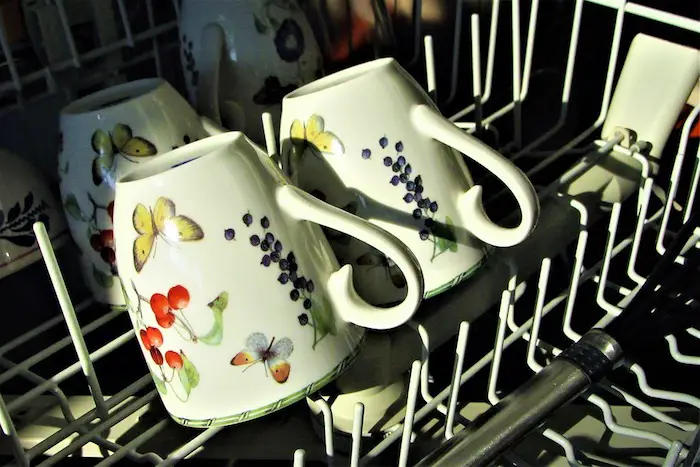If you hate doing the dishes after a wonderful mealtime, no one knows better what your dishwasher means to you. It’s probably your lifeline, something without which you cannot imagine your daily life. In case your current appliance is standing in its last leg, then you are looking for a new dishwasher.
While there are many factors to consider, one of the most important things is whether you need a filtration or hard food disposer to remove food debris. If your thoughts are divided between the two, we have created this post to discuss dishwasher filtration system vs hard food disposer.
Both these built-in systems help in getting rid of food particles and debris to give you a clean dishwasher. However, there is a slight difference between the way they function and we will discuss them below to help you make the right choice.
Dishwasher Filtration System
Take any dishwasher model that is ten years older or so, and you will find that it comprises of a built-in self-cleaning filtration system. The contemporary and latest models are more about manual filtration systems but we will discuss that later in this article.
The built-in system functions quietly to trap the food particles and debris inside the filter located at the bottom of the appliance. This prevents the food particles from getting into the washed dishes. While the self-cleaning removes the waste itself, the manual filters need frequent cleaning.
Dishwasher Hard Food Disposers
This is another style of dishwasher that includes a chopper used to break down the hard and large food particles so that they don’t get re-deposited on your clean dishes. The system removes the food particles from the dishwasher automatically so you don’t have to manually clean it.
The dishwashers with hard food disposers are often known for making a lot of noise due to the disintegration of hard food particles. Fortunately, there are a few quieter models available to do the job without causing a lot of disturbance. The biggest advantage of such appliances is that they do not need a lot of maintenance work.
Things To Know About Dishwasher With Built-In Filtration System
Have you ever wondered what happens to the soggy and dirty food particles when water and detergent circulate inside the dishwasher. This is where the built-in filtration system comes into play by trapping the food particles and collecting them in the filter beneath the base rack.
The job of a good filter is to prevent dirty food particles from getting on washed dishes and choking the drain pipe. Over these years, the manufacturers have changed their approach towards making filters to lock in dirty food from circulating inside the appliance.
Self-cleaning filters
About 10 years earlier, most of the dishwashers in the market included a self-cleaning filter but in the last decade, the industry has seen significant evolution. The recent dishwasher models are not only well-designed but they are also equipped with grinders and quieter manual-cleaning filters.
While both these approaches are effective at cleaning, they function differently. The biggest change you can notice in the last decade is that self-cleaning filters have evolved into manual cleaning options. If you are in the market looking to change your old dishwasher and get a new one, this is an important aspect to consider.
The self-cleaning filters have been around for quite some time and their biggest USP is that they don’t need a lot of attention. If you see a plastic grid inside the dishwasher or a series of holes present at the base of the machine which covers the filter, it is a self-cleaning model.
Some types of self-cleaning models may come with a grinder that is meant to pulverize food so that it moves down the drain with ease. However, the downside of such models is that the appliances tend to be very noisy.
To deal with this disadvantage, many self-cleaning filters now come with an ultrafine mesh and no grinder. As the force of water pushes the food through the filter, it breaks down food into very small particles that get washed away.
In some of the expensive dishwasher models, you can find a quieter style of self-cleaning filter. The manufacturers use good insulation to weaken the noise made by dishwashers. Although the standard models were not much preferred due to loud operational noise, a few models fair well in the noise test.
Manual Filters
The manual version of filters tends to be much quieter while operating but they do require some maintenance work. If you skip the cleaning step, the food collected in the filter may go stale and cause odor. It may also reduce the water flow, thus prevent the dishes from cleaning well.
Look at the bottom of the tub, under the plastic spray arms and you will find a plastic part resembling the type of filter you often see in some carafe water filters. It may have an arrow on the top to indicate the direction in which to turn the filter for locking or unlocking.
If you wish to clean a manual filter, you simply need to turn it and remove it. Rinse under plain running water to clean all the debris. Make sure you wipe away any gunk that may be stuck to the plastic components
Now, check the manufacturer’s website or owner’s manual to find out how often you need to clean the filter. A good sign is when you start seeing tiny bits of food particles stuck to the dishes after the wash cycle completes.
Related Article: How To Clean a Dishwasher Filter
Things To Know About Dishwasher With Built-In Hard Food Disposer
The built-in hard food disposer system works perfectly when properly integrated into a single appliance. This saves you the headache of removing leftover food and washing the dishes with water before putting them inside the dishwasher.
Both the dishwasher and waste disposer works in tandem to maximize the final output. The disposer removes even the tiniest of food particles to ensure that the dishes come out sparkling clean and the pipe also does not get clogged.
Some people wonder why do they need a hard food disposer at all. Well, the standard dishwashers are only designed to clean the dishes with detergent. They are not effective at removing the food scraps and particles.
The hard food disposals are better at handling these and cleaning dishes without leaving any residue. They are equipped with powerful choppers that can easily trash out the leftovers like stale fruit and pieces of eggshells.
Benefits of Dishwashers With Built-In Hard Food Disposer
If you are thinking of buying a dishwasher with built-in hard food disposer but are unsure of your decision then here are a few benefits that will help you decide. Read on to find out why your kitchen needs a dishwasher with integrated hard food disposer
1. Makes the cleaning up process easier
When you are in a hurry or too tired after a get-together, this allows you to skip the rinsing process after a meal. The two-in-one machine allows you to put the dishes directly into the tub. The two processes take place simultaneously to dispose of food residue and clean the dishes.
2. Minimizes spreading of debris and residue
Some people are too busy or maybe lazy to remove food waste from the dishes before putting them in the dishwasher, and this leads to one unpleasant thing – a nasty spread of debris during the wash cycle. This results in gritty and oily particles stick even in the high powered dishwashers. Hence it’s important to minimize the amount of debris or residue within the appliance to improve the overall performance.
3. Reduces pipe clogging
The nozzles and pipes of the dishwasher are prone to clogging exceptionally and small bits of food scraps can get stuck and reduce the water flow from pipes. The built-in hard food disposer minimizes the risk to a certain extent and reduces the amount of repair and maintenance required.
Other Factors To Consider When Buying A Dishwasher
The dishwasher market changes constantly with new features pouring in and models getting an upgrade. So, if you are in the market looking for a new appliance, here are a few things you may want to consider other than dishwasher filtration system vs hard food disposer mentioned above.
1. Stainless Steel Or Plastic Tub
Another important feature other than the mode of disposal is the type of material used for making the dishwasher tub. Dishwashers with a plastic tub are pocket-friendly but they have the tendency to absorb bad smell and stains over time. Stainless steel tubs require less maintenance and they can withstand higher heat levels making a 160° sanitize cycle possible. On the downside, stainless steel tubs are more expensive.
2. No of cycles/ options
In a standard model, you can find 2-4 cycles or wash options namely Light, Heavy, Normal, and Auto. Most users do not ask for more options than these, but if you belong to the group that seeks more options for different types of clothing then check out models that feature 5-10 options. These include sanitizing wash cycle, delicate, quick wash, delay wash, half load, rinse & hold. More options will mean a more expensive product, so think wisely and buy only what you need.
3. Cost of the dishwasher
When looking at the different models and their features, make sure you also consider the budget to find something that comes within it. Basic dishwasher models are between $300 to $500, while the medium-range ones are between $500 to $900 and the high-end models are $999 and above. The more features in a dishwasher, the higher will be the price so always access your needs before buying.
4. Cleaning Power
Fortunately, the cleaning power of your dishwasher is not directly related to the price you pay, although the high-end models perform better anyway. If you rinse the dishes with water before putting them into the machine, most standard models will do a good job. However, if you want to skip the rinsing process, look for a model that comes with a filtration system or hard food disposer. Check the information above for dishwasher filtration system vs hard food disposer.
5. Noise level
Contrary to the cleaning power, the noise rating of the dishwasher often correlates directly with the price. If you want a model that is noiseless, expect to pay a high price. Some low-end models are also much quieter than the appliances that are over 10 years old. The low-end models usually come with a noise level of 50 dB or more, the medium range models have mid 40 dB noise level, while the high-end models are typically less than 40 dB.
For more: Comparitive Examples of Noise Levels
6. Capacity and better space use
The capacity of a dishwasher means the number of appliances it can hold at a time. If you have a small family, a less capacity would be enough. However, if you have a large family, you will need an appliance with a higher capacity. Besides the capacity, you will also want to check the use of space inside the appliance to ensure that you can fit in small utensils and large pots and pans with ease.
Related Article: Your Dishwasher Can Run Better – 14 Tips To Boost Its Performance
Related Questions
Does the type of detergent I use impact the cleaning performance?
Yes, it does. Hence, we recommend that you use a detergent that complements the cleansing action of your dishwasher model. The automatic models use a specially formulated detergent to remove greasy wastes and food residue without forming a lot of suds. To get the best results, use the detergent recommended by your manufacturer.
Should I add salt and rinse aid separately?
Rinse aid is needed to ensure that you get spot-free and shiny dishes, and it also helps with the drying function. Adding salt to the machine helps in protecting the machine from limescale deposits and soften the hard water to ensure better cleaning.
Is it necessary to pre-rinse the dishes before adding them to dishwasher?
With the latest dishwasher models featuring advanced hard food disposal system, pre-rinsing dishes are a thing of the past. Save your time and valuable resources by skipping this step and allowing your dishwasher to do the needful.


